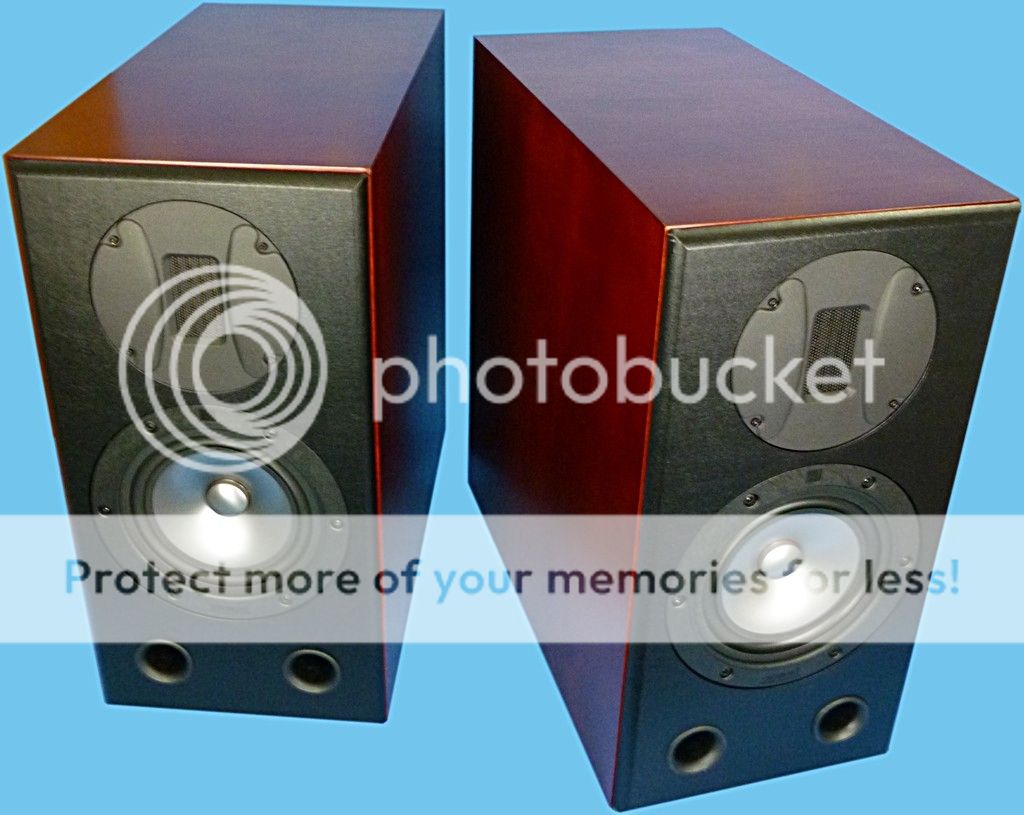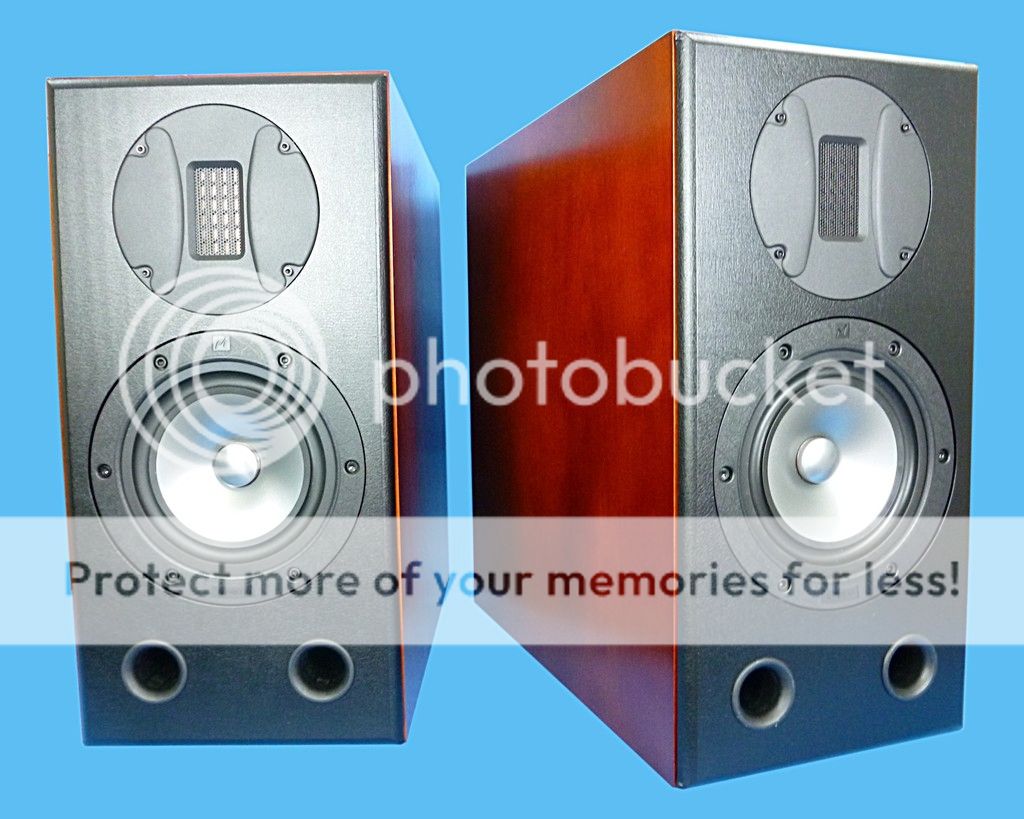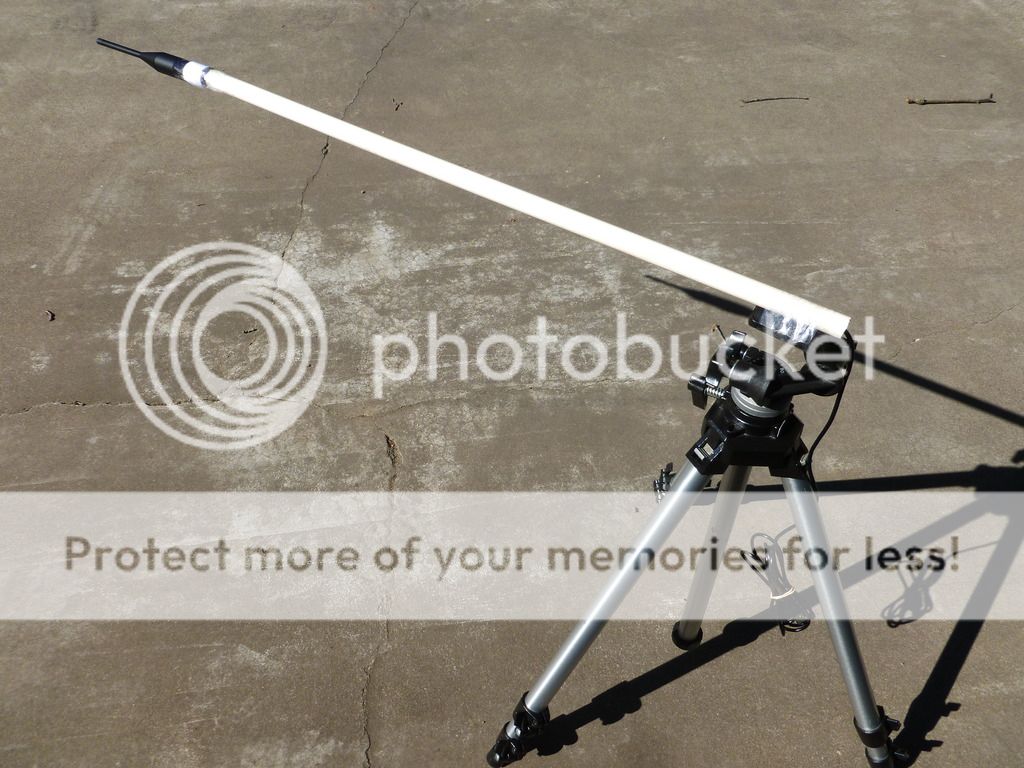They look better than most "similar" commercial offerings.
Good job!

Note: you may want to put some spacers behind the tweeter to make it fully flush with the baffle relative to the face-plate's vertical edge (..as opposed to the slight inset profile it now has).
Good job!

Note: you may want to put some spacers behind the tweeter to make it fully flush with the baffle relative to the face-plate's vertical edge (..as opposed to the slight inset profile it now has).
Last edited:
Thanks for the encouragement.
Here below is the raw output of the measurements from REW.
Testing procedure: The room is small with plenty of clutter and various soft and hard objects like carpets, metal and wooden racks and desks. I set the speaker in the middle of the room on a couple of concrete blocks and positioned the microphone (UMM-6) 1 meter away on a stand, pointing at the center between the tweeter and woofer. I turned off all mechanical works in the building like the HVAC system. There was a computer system with fans (not terribly loud) nearby however... this was used to take the measurements.
Please review the graphs below and let me know what you think I should change or do other than just convert them to FRD and proceed to crossover design. Wolf mentioned "extending the tail" on the tweeter measurements but I don't know how to do that. As you can see I was hesitant to go below 2K with the tweeters for fear of damaging them. I also don't know if I need to gate for floor bounce or not (carpet as mentioned). So these measurements are un-gated, just the most basic sweep.
The first set of four shows the drivers un-smoothed, the second set of four shows the same measurements with 1/12th octave smoothing applied so you can actually see what's going on!
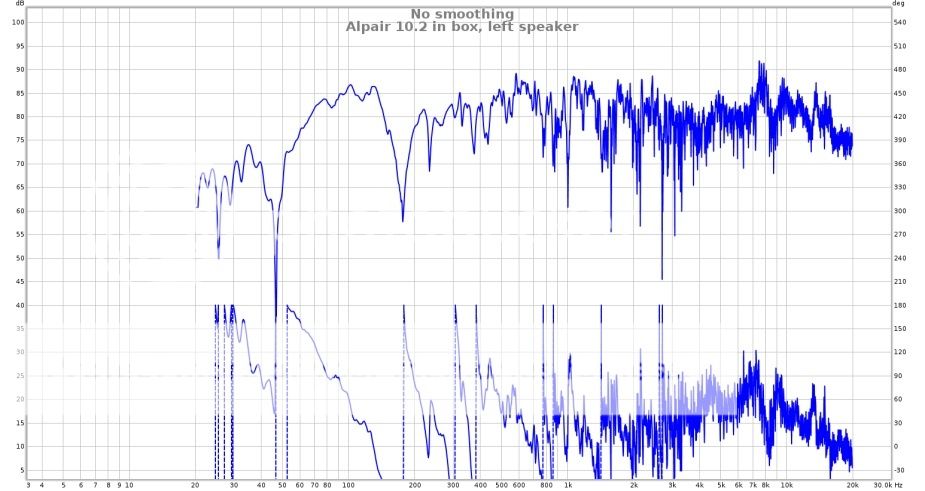
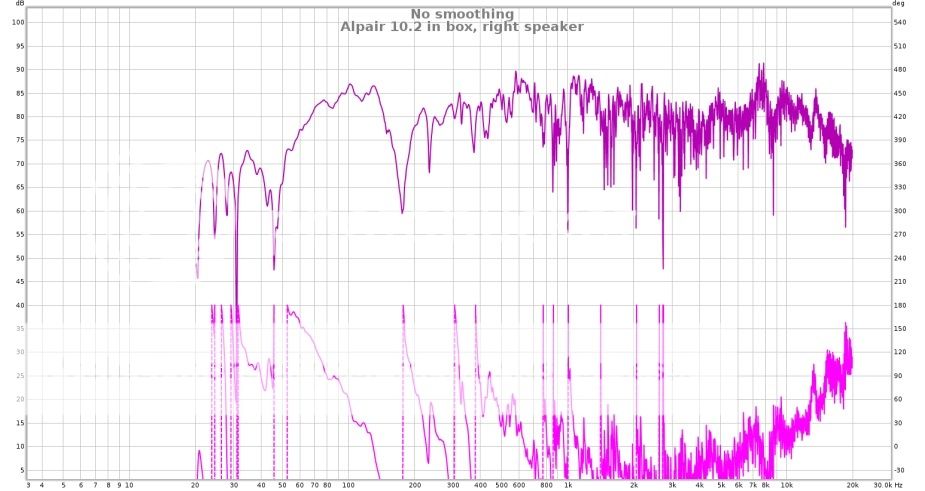
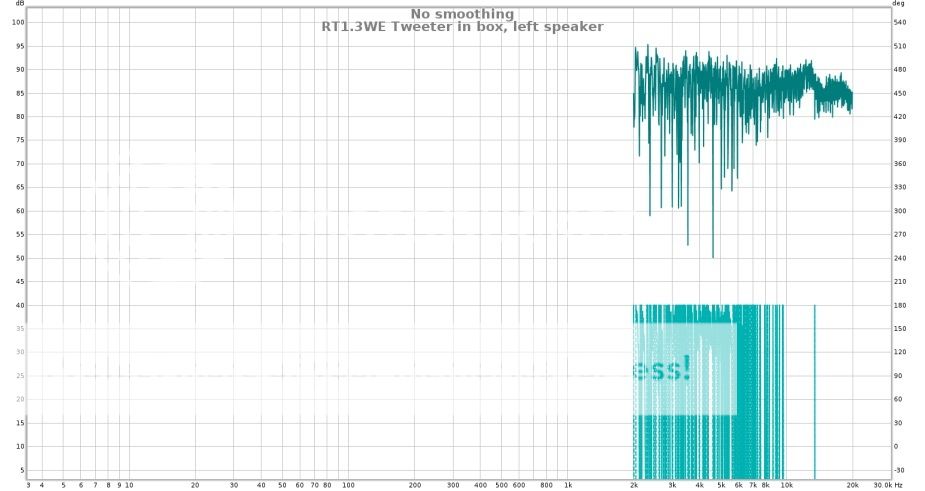

Now, with smoothing:

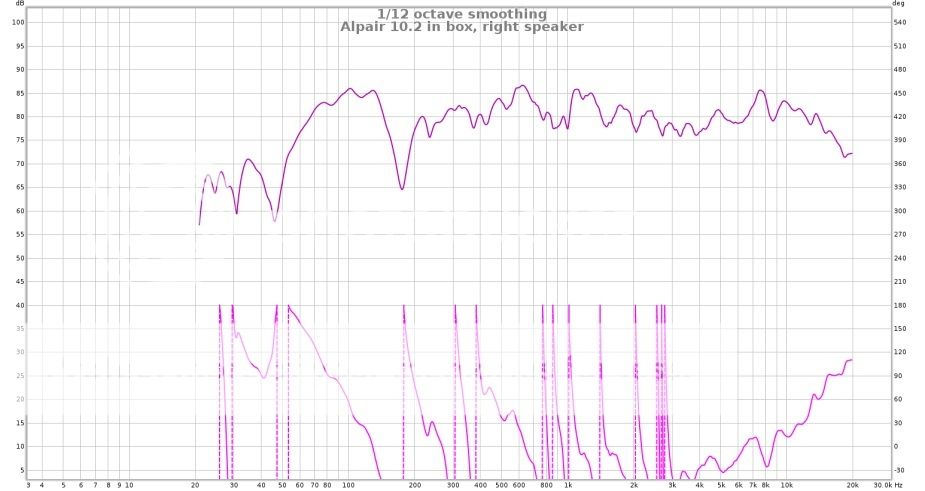


Thanks in advance for your input.
Here below is the raw output of the measurements from REW.
Testing procedure: The room is small with plenty of clutter and various soft and hard objects like carpets, metal and wooden racks and desks. I set the speaker in the middle of the room on a couple of concrete blocks and positioned the microphone (UMM-6) 1 meter away on a stand, pointing at the center between the tweeter and woofer. I turned off all mechanical works in the building like the HVAC system. There was a computer system with fans (not terribly loud) nearby however... this was used to take the measurements.
Please review the graphs below and let me know what you think I should change or do other than just convert them to FRD and proceed to crossover design. Wolf mentioned "extending the tail" on the tweeter measurements but I don't know how to do that. As you can see I was hesitant to go below 2K with the tweeters for fear of damaging them. I also don't know if I need to gate for floor bounce or not (carpet as mentioned). So these measurements are un-gated, just the most basic sweep.
The first set of four shows the drivers un-smoothed, the second set of four shows the same measurements with 1/12th octave smoothing applied so you can actually see what's going on!




Now, with smoothing:




Thanks in advance for your input.
In addition to the above, I followed the gating guide here: Loudspeaker measurements
Considerations: I put the woofer about 22" off the floor and the mic about 26" off the floor so according to this website ( https://mehlau.net/audio/floorbounce/ ) the floor reflection occurs at 1.66ms. I therefore gated at 1.53ms as that looked like a spot without a lot of activity on the impulse response before the peak around 1.7ms. Therefore, according to the article, frequencies below 653Hz would not be accurate (1/0.00153). I would imagine that would make it difficult to figure out baffle step in the crossover. Am I right? Anyway, here it is:
Anyway, here it is:
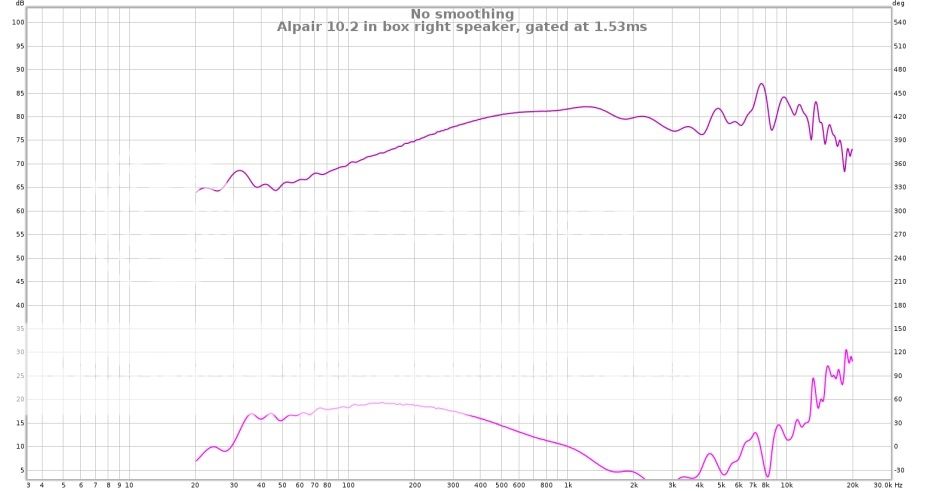
Here is the impulse response, everything after the vertical blue line is cut off basically...
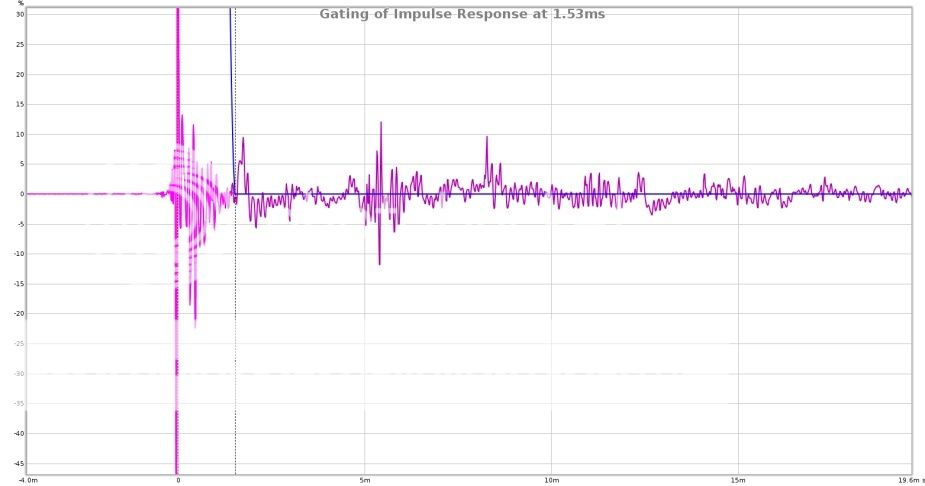
Am I on the right track? Do I need to gate the tweeter response too?
Thanks guys
Considerations: I put the woofer about 22" off the floor and the mic about 26" off the floor so according to this website ( https://mehlau.net/audio/floorbounce/ ) the floor reflection occurs at 1.66ms. I therefore gated at 1.53ms as that looked like a spot without a lot of activity on the impulse response before the peak around 1.7ms. Therefore, according to the article, frequencies below 653Hz would not be accurate (1/0.00153). I would imagine that would make it difficult to figure out baffle step in the crossover. Am I right?

Here is the impulse response, everything after the vertical blue line is cut off basically...

Am I on the right track? Do I need to gate the tweeter response too?
Thanks guys
First read this:
http://www.google.hr/url?sa=t&rct=j...CH7-TrqtujJtzPA&bvm=bv.95515949,d.ZGU&cad=rja
You tweeter is isodynamic, it has resistance all the way to dc. You don't have
to measure your drivers at 2,83V. It can be lower than that.
See that your cabinet is properly damped with stuffing. You can check it either
by measuring impedance or spl. The cabinet axial modes are most energetic and
I'm afraid your lining is not enough. Vent should be clear from stuffing.
Adjust the time window so it shows the floor bounce too. You want to see
the baffle step. Usually it's smart to smooth the measurements out so you
can see more clearly.
http://www.google.hr/url?sa=t&rct=j...CH7-TrqtujJtzPA&bvm=bv.95515949,d.ZGU&cad=rja
You tweeter is isodynamic, it has resistance all the way to dc. You don't have
to measure your drivers at 2,83V. It can be lower than that.
See that your cabinet is properly damped with stuffing. You can check it either
by measuring impedance or spl. The cabinet axial modes are most energetic and
I'm afraid your lining is not enough. Vent should be clear from stuffing.
Adjust the time window so it shows the floor bounce too. You want to see
the baffle step. Usually it's smart to smooth the measurements out so you
can see more clearly.
You tweeter is isodynamic, it has resistance all the way to dc. You don't have
to measure your drivers at 2,83V. It can be lower than that.
hello Lojzek, Do you mean I should measure lower than 2K on the tweeter? How low? Also using less volume on the amplifer during measurement would mean that background noise would have more of an effect on the results, right?
Also, wouldn't it be easier to tell if there is an issue with axial modes as you say if I close-mic the woofer from about 3" away?
Thanks for the link, Jeff is quite a resource for us DIY'ers. I'll probably re-do all the measurements and this time take a third measurement with the woofer and tweeter connected in parallel as Jeff suggests. The 8ms gating that Jeff suggests will include a lot of room reflections though, not too sure on that. His room must be pretty big.
Last edited:
Unless you've got a very high ceiling, the best you're going to get with no reflections is probably around 4.5 ms or less, and probably not at 1 meter. Anyway, measure the drivers a bunch to get a feel for what's going on at different angles and how you can get longest time window without creating problems before you worry about any exporting and etc. Use the overlay view to watch changes happen.
Don't put the speaker in the middle of the room (think about the path distances from speaker to mic with reflections). That thing Geddes wrote has a drawing toward the end that shows around where you'd want it in an empty room. With anything similar to that, floor or ceiling sets the limit along with mic distance.
P.S. change your impulse graph scale for a better view of the first 6 ms impulse, and the response dB axis to about half as much range, no need for 105dB of graph for 20dB of response.
Don't put the speaker in the middle of the room (think about the path distances from speaker to mic with reflections). That thing Geddes wrote has a drawing toward the end that shows around where you'd want it in an empty room. With anything similar to that, floor or ceiling sets the limit along with mic distance.
P.S. change your impulse graph scale for a better view of the first 6 ms impulse, and the response dB axis to about half as much range, no need for 105dB of graph for 20dB of response.
I also found Troels Gravesen's advice about microphone mounting. I'm not going to buy the right equipment but I think I can rig up something better than what I was doing with just pvc pipe and a heavy tripod and lots of tape.
Loudspeaker Measurements
For the measurements above I was just using the mic grip on top of a basic tripod..... newbie mistake I guess.
Still waiting for an answer about how low to go in frequency for the tweeter measurements because I don't want to break anything... or is a 2K lower limit all right? Not sure. Lojzek's "it has resistance all the way to dc" sounds like we are talking about feeding this little tweeter a 20 Hz signal, that can't be right. Maybe 1K?
Loudspeaker Measurements
For the measurements above I was just using the mic grip on top of a basic tripod..... newbie mistake I guess.
Still waiting for an answer about how low to go in frequency for the tweeter measurements because I don't want to break anything... or is a 2K lower limit all right? Not sure. Lojzek's "it has resistance all the way to dc" sounds like we are talking about feeding this little tweeter a 20 Hz signal, that can't be right. Maybe 1K?
Next I'll work on measurements and then ask you all to put your crossover design caps on to make sure I come up with a crossover worthy of these.
I would rather copy
Audioplay - PlayMax K-01
The high pass is very clever and effective
Still waiting for an answer about how low to go in frequency for the tweeter measurements because I don't want to break anything... or is a 2K lower limit all right?
-gate it as low as the room will allow. Start the sweep lower in freq. than that.
Oh, also measure at different distances for the same axis (and of course multiple axis's) to get a "feel" for the gradient and crossover integration. Diffraction will alter the response. For the most part you are "shooting for" a 2 meter response - which (generally) you'll need to take outside to get.
Last edited:
Lojzek's "it has resistance all the way to dc"
Means that it's a stable load for the amp and resulting measurement. Which is

If you are paranoid, by a large value non-polar electrolytic cap to put in series.
https://www.madisoundspeakerstore.com/bennic-electrolytic-capacitor-100vdc/
Last edited:
Still waiting for an answer about how low to go in frequency for the
tweeter measurements because I don't want to break anything...
Hi Ben,
Ok, I am awake now. I don't want you to break the tweeter either.
This might help:
Zaph|Audio
About stimulus level control, you could try to lower the voltage level
and leave it there where your S/N is still okay. I don't work with REW,
occasionally I turn on HOLM Impulse, mostly I use Clio.
You'll have to do something about recording the tweeter in the way
you see the response rolling off to midrange.
Regarding standing waves, yes, mic closer to woofer will do.
A quick check on calculating modes: Fr=half of speed of sound/dimension
Standing wave of 30 cm height= 172/0,3=573 Hz
From the link to Zaph's info above, I see he uses a 20 uF cap on the positive leg of the tweeter.
However I see in the manufacturer's spec sheet for the RT1.3WE that the response tapers off around 1K (see picture below). So, do you guys think it would be safe enough to NOT use a cap and just set the lower cutoff frequency of the sweep to 1K? Would that not damage the tweeter? Would that give me enough data for crossover design?
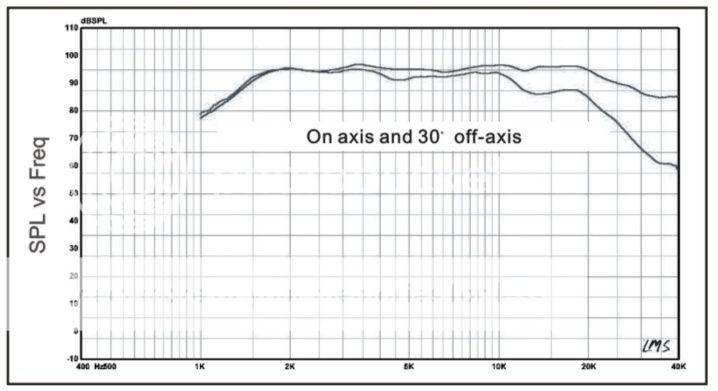
Thanks for all the help.
However I see in the manufacturer's spec sheet for the RT1.3WE that the response tapers off around 1K (see picture below). So, do you guys think it would be safe enough to NOT use a cap and just set the lower cutoff frequency of the sweep to 1K? Would that not damage the tweeter? Would that give me enough data for crossover design?

Thanks for all the help.
I don't see a reason why you shouldn't lower the stimulus cut-off
frequency to 1000 Hz. Manufacturer says nominal power 10 W.
Let's say a ribbon can survive 1 W of average power for a longer
period, like hours. When you finish that measurement, use the
spreadsheet "Frequency Reponse Modeler" where you can draw
the rest of the response with a high pass function at the frequency
of your interest (1 kHz) so the minimum phase resembles a driver
that was recorded with no frequency constrictions.There you will
have the software calculate the minimum phase for the woofer too,
if your measurement gear doesn't do that automatically.
frequency to 1000 Hz. Manufacturer says nominal power 10 W.
Let's say a ribbon can survive 1 W of average power for a longer
period, like hours. When you finish that measurement, use the
spreadsheet "Frequency Reponse Modeler" where you can draw
the rest of the response with a high pass function at the frequency
of your interest (1 kHz) so the minimum phase resembles a driver
that was recorded with no frequency constrictions.There you will
have the software calculate the minimum phase for the woofer too,
if your measurement gear doesn't do that automatically.
Last edited:
Thanks for all the help.
Barring something like amplifier signal low freq. "thump" you shouldn't have any problem hitting the tweeter with 2.83 volts at 100 Hz.
The reason of course is that the driver has it's own mechanical "high-pass filter" - almost 60 db down by 100 Hz.
IF you are afraid of lower freq. "thump" then use a 3 dollar bennic cap.
If you are simply afraid of the test signal, then stop - and use the test as fullrange as your room will allow. If you can't do that then still use a similar lower freq. start for your sweep, but use a lower voltage and move the mic closer to the speaker.
Note: IF you have a cheap tweeter laying about, then you can always try it out with that first..
Last edited:
My Yamaha A/V receiver has no turn on thump but I make sure to turn the volume all the way down before turning it off so it is always at 0 upon turn-on as a precaution.
I suppose since one of you says to do 100 Hz and another 1K, I'll split the difference and set the sweep for 500Hz to 20K on the tweeter, I'm sure that will be enough for crossover design since we are talking about a 3K crossover frequency here.
I suppose since one of you says to do 100 Hz and another 1K, I'll split the difference and set the sweep for 500Hz to 20K on the tweeter, I'm sure that will be enough for crossover design since we are talking about a 3K crossover frequency here.
My Yamaha A/V receiver has no turn on thump but I make sure to turn the volume all the way down before turning it off so it is always at 0 upon turn-on as a precaution.

- Status
- This old topic is closed. If you want to reopen this topic, contact a moderator using the "Report Post" button.
- Home
- Loudspeakers
- Multi-Way
- Ben's "Hi-Marks" Fullranger + Isodynamic Tweeter 2-Way Build Thread
